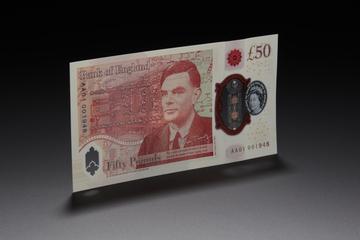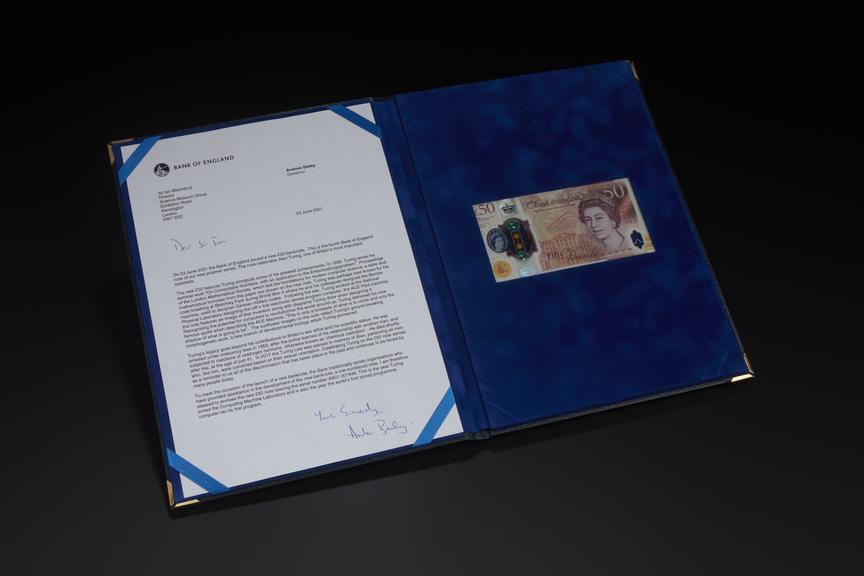
£50 banknote featuring Alan Turing
2021

Polymer £50 note with accompanying letter and presentation folder. The banknote was issued by the Bank of England, to enter circulation on 23 June 2021. It features the mathematician Alan Turing.
On 23 June 2021 this newly designed £50 note was brought into circulation by the Bank of England. It is the first polymer £50 note to be produced in pound sterling. Polymer notes contain security features including transparent windows and holograms which make them very difficult to counterfeit. They also last longer and stay in better condition than paper notes.
A competition to choose a scientist to feature on the new £50 note was launched at the Science Museum in London in November 2018. The chosen scientist, British mathematician and computing pioneer Alan Turing, was revealed at the Science and Industry Museum in Manchester in July 2019.
This note, given to the Science Museum Group by the Bank of England, has the serial number AA01 001948. 1948 was the year Alan Turing joined Manchester University’s Computing Machine Laboratory to work on a new stored-program computer.
Alan Turing’s code breaking work and visionary ideas about machine intelligence made him one of the most influential thinkers of the 20th century. The design of the £50 note features artwork relating to his life, work, and achievements. The note’s ticker tape design depicts his birth date, 23 June 1912, in binary code. The portrait is based on a photograph taken of Turing by Elliot & Fry in 1951.
The note’s artwork includes a mathematical table and formulae from Turing’s seminal 1936 paper, ‘On Computable Numbers, with an application to the Entscheidungsproblem’, which he published aged 24. This paper is widely recognised as being foundational for computer science.
Technical drawings for the bombe, the Second World War Enigma-code breaking machine that Turing developed at Bletchley Park also feature on the note.
An illustration of the Automatic Computing Engine (ACE) pilot model, which was developed at the National Physical Laboratory in 1950 as the trial model of Turing’s pioneering design also features. The ACE was one of the earliest electronic stored-program digital computers.
The flower-shaped, red foil patch on the back of the note is based on an image of a sunflower head, representing Turing’s study of the mathematical patterns found in nature. Turing left this work unfinished after his untimely death in 1954, aged 41, two years after his conviction for gross indecency under anti-gay laws of the time.
The quotation shown on the note, which reads ‘This is only a foretaste of what is to come and only the shadow of what is going to be’ is from Alan Turing, given in an interview to The Times on 11 June 1949. Turing’s signature, taken from the visitor's signature book at Bletchley Park, also features.